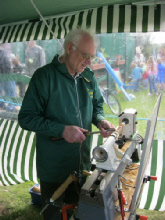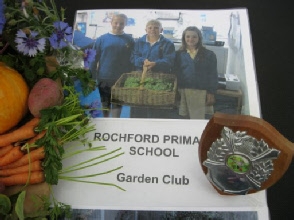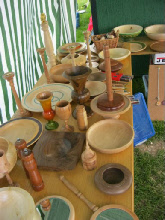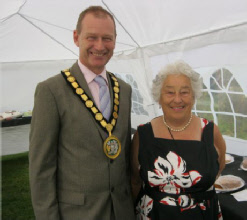

Make a point of visiting us weekly!
Return to Allotment Association CONTENTS PAGE
Rochford Allotment Association
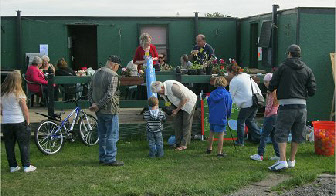
The RAA Open Day - Saturday September 17th 2011
The Open Day at the allotments on Saturday was what, I suspect, is classic Britain at its best. I’ve wandered around shows in the past with little understanding but at this one I managed to get the two judges to walk round the produce marquees and explain the art of judging. The displays of vegetables, fruit, flowers and handicrafts suggested a lot of hard work (and friendly rivalry, I suspect).
The stewards had set up the marquees the evening before and had been on site early that morning to receive the entries. After the judges had had time to go round and make their awards, the gates were open to the public at midday.
The Open Day at the allotments on Saturday was what, I suspect, is classic Britain at its best. I’ve wandered around shows in the past with little understanding but at this one I managed to get the two judges to walk round the produce marquees and explain the art of judging. The displays of vegetables, fruit, flowers and handicrafts suggested a lot of hard work (and friendly rivalry, I suspect).
The stewards had set up the marquees the evening before and had been on site early that morning to receive the entries. After the judges had had time to go round and make their awards, the gates were open to the public at midday.
The sun shone brightly and the wind blew! Full marks for perseverance to all concerned, especially after the wind blew a complete table over in the marquees, and everything on that table needed recovering and putting out again.. Elsewhere on the allotments there was archery by Clements Bowmen who meet at Watermans School. (For further details contact Tracy on 07766333682.)There was also a tent producing burgers and hot dogs, a tent with John English (see his page) demonstrating wood turning and produce-for-sale tables. But it’s people that make these times work. Shortly after midday the Chairman of Rochford District Council, Simon Smith, officially opened it and wished everyone well. Button-holing the two judges, I got them to educate those of us not so well versed in the art of judging:
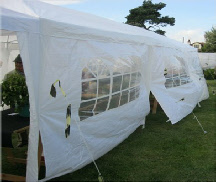
Produce-for-sale tables attracted many.
Full marks for the stewards for keeping the marquees from blowing away! I’m told it did later!!!
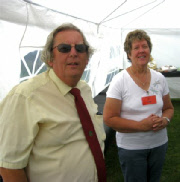
The Judges Robert Wiseman and Di Nice.
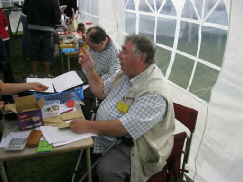
Allotment Chairman David Patmore oversees the proceedings and sorts prizes
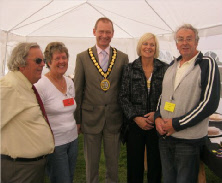
Council Chairman, Simon Smith opened the proceedings.
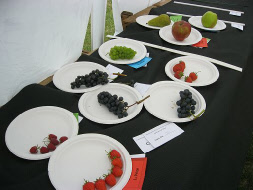
Rochford did their first Show last year which he judged and so this was his second time in Rochford and they had booked him for next year already.
I started by asking him the obvious: How do you judge?
I started by asking him the obvious: How do you judge?
Robert: “Condition, quality, correct size for the variety, good size for the variety, uniformity (say three or four in a display that are all the same). The requirement for potatoes for example are that they fit neatly in the palm of the hand, and uniformity in terms of shape. With onions it is uniformity and good condition, not over skinned but clean. With carrots again, uniformity, avoidance of damage if possible, and nice quality. With flowers such as the fuchsia, you are looking at quality in terms of shape as well as healthy leaves and flowers. The type may not be to my liking but that’s beyond the point – I was once told you judge in black and white unless it calls for a specific colour. That way you’re not being biased if, say, your favourite colour is red or whatever.
I was intrigued so a follow up question seemed equally obvious: Did you have to do anything to become a judge?
Robert: “I did two years training and took four exams. For daffodils and roses I’m a national judge and took two exams each, and for the Essex Guild I did two exams, one of one hour and one of eight hours. Sometimes it is quite straight forward; you also judge according to class so here, for instance, it is simply the biggest sunflower. (He pauses to encourage some young people to put in entries next time – every entry is worth it!)
Robert: “I did two years training and took four exams. For daffodils and roses I’m a national judge and took two exams each, and for the Essex Guild I did two exams, one of one hour and one of eight hours. Sometimes it is quite straight forward; you also judge according to class so here, for instance, it is simply the biggest sunflower. (He pauses to encourage some young people to put in entries next time – every entry is worth it!)
Having picked out the ‘important people’ of the Show, we now need to readjust our vision and recognise the really important people, the unseen people to submitted all the produce to be judged. Congratulations to you all! This is all about you!
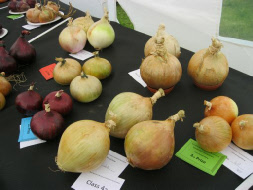
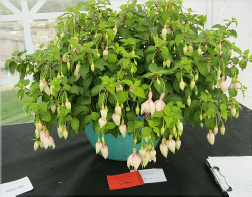
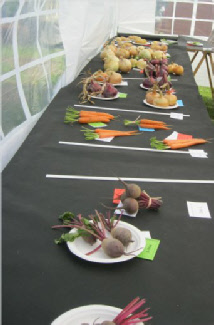
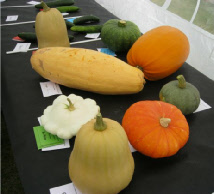
Robert Wiseman was the judge of the fruit and veg and has been judging for over twenty years in this country and as far away as Belfast, normally doing between ten and fifteen shows a year – some of the RHS Dahlia shows in the South East England and others in East Anglia
I can’t help asking: Do people ever get stressed because they don’t agree with your judging?
Robert: “Oh yes, often, but sometimes it is very easy so here we have the longest bean group and you simply measure them and the winner is obvious. Or there may be heaviest potato or heaviest tomato. Where it becomes more challenging is where you have lots of different vegetables in the same class.
Robert: “Oh yes, often, but sometimes it is very easy so here we have the longest bean group and you simply measure them and the winner is obvious. Or there may be heaviest potato or heaviest tomato. Where it becomes more challenging is where you have lots of different vegetables in the same class.
I thank him and move on to the second judge, Diana Nice.
I have become intrigued with the whole process so ask very simply, “How do you come to be a judge?”
Di: “I suppose because I’ve been dealing with horticulture etc. for about thirty five to forty years. I was show secretary at Hockley Horticultural for about thirty years and always stewarding, jumping in as judge when any horticultural society couldn’t get a judge and it’s gone from there. Here today I judged all the home-craft which includes all the cooking.”
Would I ever dare have the courage to cook something and put it in a show? I doubt it, but others have, so the obvious question is, “How do you judge the cakes?”
Di: “Well you start by having different classes so you have, for example, fruit cakes in one class or sponges in another. You start with the overall look of any of them, then with cakes you cut them in half and take a piece out and taste it, so mentally you are giving it so many marks for presentation and so much for taste. You can’t always go by what looks the best because it could look the best but taste awful, so you have to check both. If there are criteria that they have to use certain ingredients or it’s got to be a certain size, then it has to match them. I put little comments on the labels. There was one that was a little undercooked and so I couldn’t give it first, even if it was the only one in that class. With jams, for instance, you take the top off and with one there, there was a little mould on the top so that can’t win.”
I have to come realise, even from Robert’s comments, that there is a lot more to this judging business than meets the eye. Is there a list of criteria?
Di: “I suppose because I’ve been dealing with horticulture etc. for about thirty five to forty years. I was show secretary at Hockley Horticultural for about thirty years and always stewarding, jumping in as judge when any horticultural society couldn’t get a judge and it’s gone from there. Here today I judged all the home-
Would I ever dare have the courage to cook something and put it in a show? I doubt it, but others have, so the obvious question is, “How do you judge the cakes?”
Di: “Well you start by having different classes so you have, for example, fruit cakes in one class or sponges in another. You start with the overall look of any of them, then with cakes you cut them in half and take a piece out and taste it, so mentally you are giving it so many marks for presentation and so much for taste. You can’t always go by what looks the best because it could look the best but taste awful, so you have to check both. If there are criteria that they have to use certain ingredients or it’s got to be a certain size, then it has to match them. I put little comments on the labels. There was one that was a little undercooked and so I couldn’t give it first, even if it was the only one in that class. With jams, for instance, you take the top off and with one there, there was a little mould on the top so that can’t win.”
I have to come realise, even from Robert’s comments, that there is a lot more to this judging business than meets the eye. Is there a list of criteria?
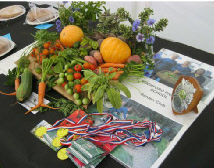
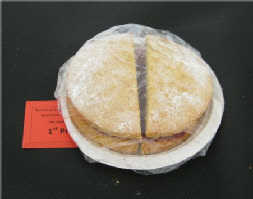
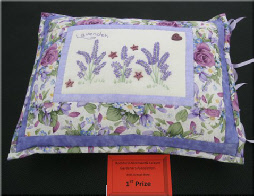
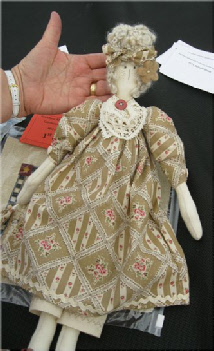
Di: “Yes, we go according to a Horticultural Guideline. There is a book which tells you the do’s and dont’s. For instance jam has got to be full up to the top and it’s obviously got to be the pound if it’s a pound jar, free of mould and tasting good and not be too runny and that sort of thing. If the standard is not there we won’t aware the first prize. But people have put effort in so you don’t pull them down otherwise that’s too discouraging and they might not put in again, and so you’ve got to be mindful of all these things when you’re judging.
I look around the tables. “So are you telling me you judged the wood turning as well?”
I look around the tables. “So are you telling me you judged the wood turning as well?”
Di: “Yes, that’s right. I put the little piece first because although they are both excellent the smaller one has so much incredibly intricate work in it and out of the two that one was the most difficult. Then of course there is all the needlecraft and the Best in Show – because we have to decide between the vegetables, flowers and all the craft – was this doll because it is so beautifully done. There are also children’s classes and I judge the children’s work as well.”
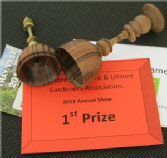
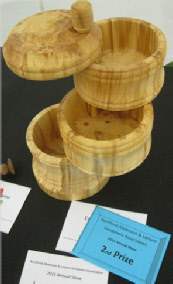
We continue to work around the tent admiring the produce and I marvel afresh at this very British activity. Really excellent and very enjoyable, but all the more so having some insight to what goes into the growing and the judging of all the produce. The names on the entry labels are left face down so the judges cannot see who has submitted what produce, so I’m unable to comment on individual achievements. I am, however, left with a sense of awe: how do you grow onions that big? One display clearly came from the children of Rochford Primary School who, with the help of the Allotment Association have set up a garden at the school. A good display, and a great achievement kids. Well done that school! I take a last look around the marquee before going to turn down a burger and think to myself, “I really must retire and go and grow some decent tomatoes!” If you didn’t go, you missed a good time out on Saturday but, hey, next year will be around before we know it.
